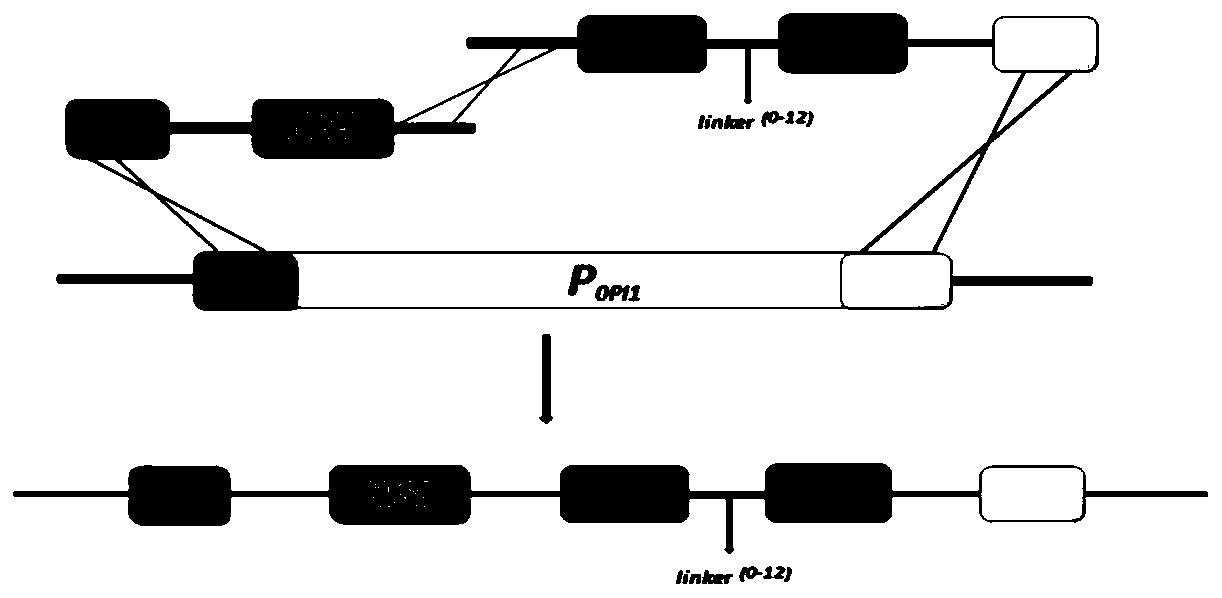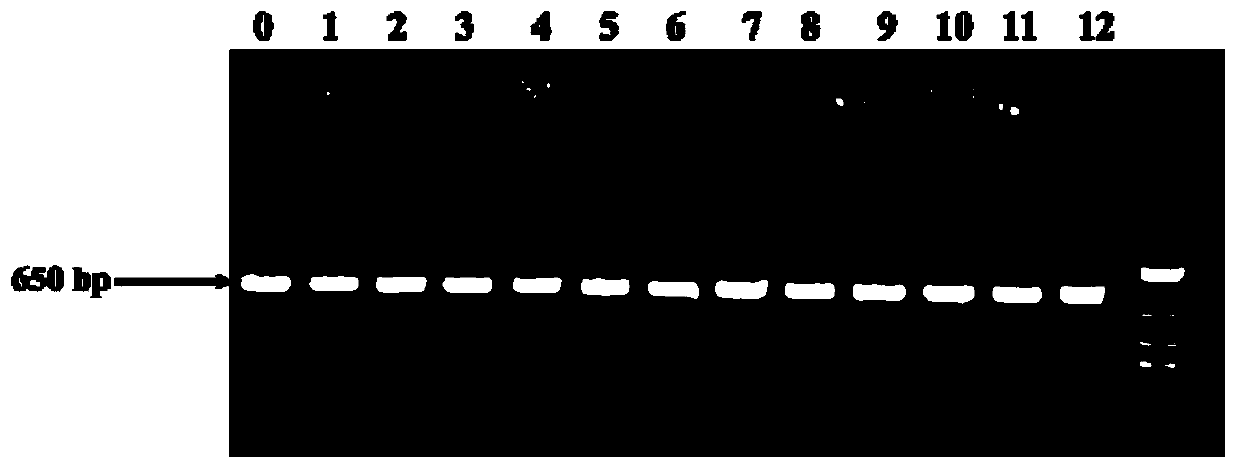Method for improving efficiency of synthesizing glucaric acid by saccharomyces cerevisiae engineering strain
A technology for glucaric acid and Saccharomyces cerevisiae is applied in the field of improving the efficiency of synthesizing glucaric acid by engineering strains of Saccharomyces cerevisiae, which can solve the problems of unbalanced flow of host cells, lack of natural metabolism regulation mechanism of host cells in heterologous proteins, etc., and achieve stable expression. Effect
- Summary
- Abstract
- Description
- Claims
- Application Information
AI Technical Summary
Problems solved by technology
Method used
Image
Examples
Embodiment 1
[0028] Example 1: Obtaining of MIOX4-linker-udh integrated fragment
[0029] Using the genome of Bga-001 (disclosed in a patent application with publication number CN108220176A: a method for improving the fermentative production of glucaric acid by Saccharomyces cerevisiae engineering strains) as a template, first use MIOX4-LF / MIOX4-LR as primers to amplify PTEF1-MIOX4 fragment; then amplified with UDH-F (0-12) and UDH-R without linker, and contains the following 12 different linkers: GSG, GSGGGGS, GSGEAAAK, GSGEAAAKEAAAK, SGMGSSSN, PTPTP, PTPTPTPTP, PTPTPTPTPTPTPTP , EAAAAK, EAAAAKEAAAAAK, EAAAAKEAAAAKEAAAAK, and UDH-TCYC1 fragments of SSSNNNNNNNNNN, and then use MIOX4-LF and UDH-R to perform fusion PCR on the above two fragments to obtain PTEF1-MIOX4-UDH-TCYC1 DNA fragments connected by 12 different linkers ( figure 1 and figure 2 ).
[0030]Then with the genome of Bga-001 as a template, the HIS3 fragment shown in SEQID NO.5 (containing the upstream homologous sequence o...
Embodiment 2
[0031] Embodiment 2: Detection of MIOX4-linker-udh integrated bacterial strain
[0032] Extract the genome of the yeast transformant obtained by the above method, use MD-Check-(opi1)F / MD-Check-(opi1)R as primers to amplify the extracted genome, and verify whether the MIOX-UDH1 fusion protein is integrated into the BY4741opi1Δ strain genome, image 3 It can be explained that there are MIOX and UDH fusion proteins on the genome of the verified strains, and finally the correct integrated strains were obtained, which were named Bga-L1-Bga-L13 respectively.
Embodiment 3
[0033] Example 3: Fermentative synthesis of glucaric acid by fusion expression engineered bacteria
[0034] 1. Preparation of seed solution: Streak the bacteria preserved in glycerol on the plate, pick a single colony and inoculate it in 10 mL of YPD medium, culture at 30°C, 250 rpm, and shaker for 24 hours to obtain the seed solution.
[0035] 2. Fermentation conditions: Inoculate the seed liquid into a 250mL Erlenmeyer flask containing 50mL liquid medium according to the inoculum amount of 5%, the glucose concentration in the fermentation medium is 20g / L, and add 10.8g / L inositol . Cultivate for 240 hours at 30° C. with a shaker rotation speed of 250 rpm.
[0036] 3. Product detection: Take 1 mL of fermentation broth, centrifuge at high speed for 10 minutes, retain the supernatant and filter it with a 0.22 μm filter membrane, and the filtrate is the sample. It can be detected by liquid chromatography-mass spectrometry (LC-MS), or detected by high performance liquid chromat...
PUM
 Login to View More
Login to View More Abstract
Description
Claims
Application Information
 Login to View More
Login to View More - R&D
- Intellectual Property
- Life Sciences
- Materials
- Tech Scout
- Unparalleled Data Quality
- Higher Quality Content
- 60% Fewer Hallucinations
Browse by: Latest US Patents, China's latest patents, Technical Efficacy Thesaurus, Application Domain, Technology Topic, Popular Technical Reports.
© 2025 PatSnap. All rights reserved.Legal|Privacy policy|Modern Slavery Act Transparency Statement|Sitemap|About US| Contact US: help@patsnap.com



